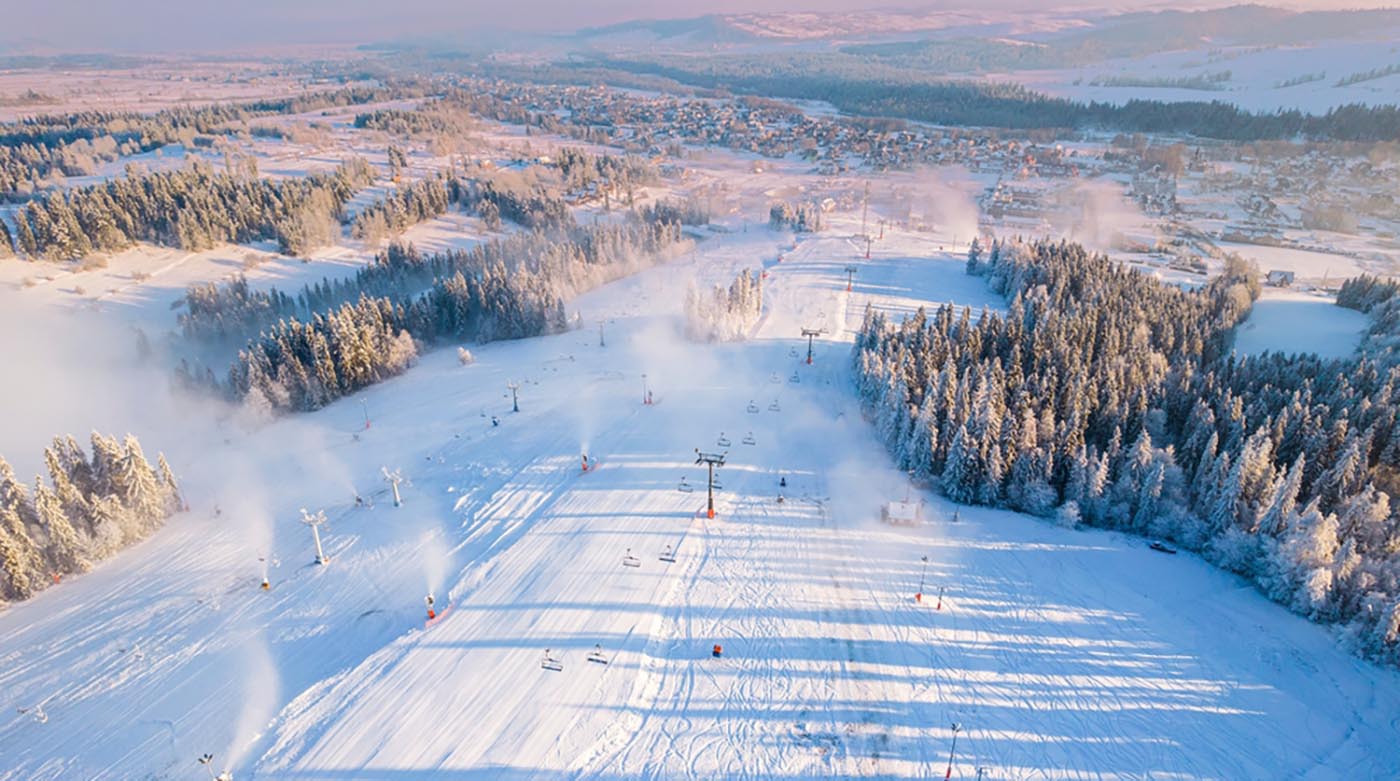Every piste ski slope is rated by experience and difficulty. You can try runs designed for beginner, intermediate and advanced skiers at any significant park, but what do these rankings mean, and how do you know which one is right for you? Getting on the wrong lift could expose you to jumps, obstacles and steep slopes beyond your means, which increases your risk of injury.
Learn how to interpret ski slope ratings to stay within your experience level.
How Do Ski Slope Ratings Work in North America?
Ski slopes designate how much experience you’ll need to complete the run. They may also indicate what kinds of terrain the trail includes. The slope angle is measured in percentage instead of degrees up to a 90-degree right angle, with 50 percent representing 45 degrees.
In the U.S. and North America, most trails are rated beginner, intermediate or expert (advanced).
Beginner trails are marked with a green circle and have gradients between six percent and 25 percent. They have compact snow, groomed runs and wide lanes to help you practice the basics. The reduced gradient keeps you in control of your speed, giving you plenty of time to turn. Green runs are designed for new skiers. The turns give you ample warning to prepare. The moderate descent angle limits your speed to keep you in control.
Intermediate trails have a blue square and a 25 percent and 40 percent gradient. The path is steeper to increase your speed with more turns. Some have jumps or ramps for getting air. The snow is less groomed and may be deep or slick in some areas. Blue runs throw more curveballs your way, including tighter turns and less predictable terrain. You’ll need experience braking and turning on a dime without losing your balance to hit blue slopes.
Advanced North American trails have a black diamond, with 40 percent and up gradients. They feature challenging terrain, chutes, gullies, bumps and ungroomed areas with fresh powder. The run will be narrow, so keep a safe distance from the next closest rider.

Source: Adam Melnyk/Shutterstock.com
Expert-only trails or double black diamond slopes are best left to professionals. You’ll encounter the trickiest turns, rough terrain and steep drops that can send you in the wrong direction. Black diamond runs require years of experience and expert coordination. Only the most seasoned skiers and moguls should attempt them. Great persistence leads to great rewards. These trails have fewer riders, giving you more access to fresh powder. Black slopes can also feature extreme terrain that can damage your equipment if you’re not careful. Expect to find more rocks, vegetation outgrowths and winding curves with limited openings. The steep incline maximizes your speed, giving you the momentum to get through or over obstacles. Ride single file with at least 10 feet in between each skier to make it through unscathed.
Backcountry or off-piste trails are marked with red dashes or a similar shape. They are entirely ungroomed, contain more obstacles and wildlife, have steep slopes and have few to no markers. Use navigation to find your way back to the resort or park entrance.
You’ll find a healthy mix of ratings at most parks. Most devote 25 percent to beginners, 50 percent to intermediates and 25 percent to expert skiers.
All ski resorts rank their trails, so expect these gradients to vary from location to location. Trails that fall between these categories will have a combined symbol. For example, a beginner-intermediate trail would have a green circle over a blue square.
With the steepest drops, expert trails are harder to access, often with remote start locations. First-time skiers may have trouble getting off the lift. Get ready to hit the ground skiing and read the markings on the lift to avoid landing on the wrong trailhead. Learn about the different types of skiing and the skills they require.
International Ski Slope Ratings
Visiting ski resorts outside the U.S.? European resorts mark beginner trails with a blue circle, intermediate trails with a red circle and expert runs with a black circle. Japan and Asia use a green circle for beginners, a red circle for intermediates and a black circle for experts. The shapes may change, but the same colors are usually used to denote trail difficulty.
How Are Ski Slopes Rated?
Resorts design their ski run difficulty levels to make it easy for skiers to identify trails that suit their abilities. Each run receives a rating based on the number of turns and drops, the angle of the turns, terrain conditions, average skier speed and other factors that affect accessibility.
Use Ski Helmet Communication to Stay Safe on Any Slope
Tips for Choosing a Ski Slope Rating
Now that you understand the basics of ski slope ratings, here are some tips to keep in mind when choosing what run to go down.
Ask an Instructor or Park Employee
No one knows the ratings better than the people who run them for a living. Talk to an instructor, park attendant or rental clerk to learn about each run. Visit the resort’s website to learn about the ski trail rating system.
If you’re unsure if you’re ready to attempt a certain difficulty, have an experienced skier evaluate your skill level. A private instructor can also guide you through the trail to ensure a successful run.
Pair Up
Hit the trail with another skier, ideally someone with more experience who can talk you through your descent. They can share tips, point out obstacles and changes in the terrain and give feedback on your stance.
Use ski helmet communication to connect wirelessly to your companion or group. It pairs with your helmet and uses dynamic mesh communication to create a direct link between each unit so you won’t get disconnected if someone falls out of position. The device connects automatically using Bluetooth to your phone and Mesh to other devices in your group to keep you focused on the run. Pairing with a snowboarder? Use snowboard helmet communication to connect everyone in your group. Speak to the receiver to contact another rider hands-free if you need help or have questions about the turn.
Err on the Side of Caution
When in doubt, choose the less challenging trail. If you quickly master it, you can always try the next most challenging slope tomorrow.

Source: WR studio/Shutterstock.com
Make Ski Slope Difficulty Ratings Work for You
Ski slope ratings help you find runs that meet your needs and experience level. They are vital to understanding any park and staying safe in new areas. Use these guidelines to have fun on your next vacation so you can confidently handle everything headed your way.





